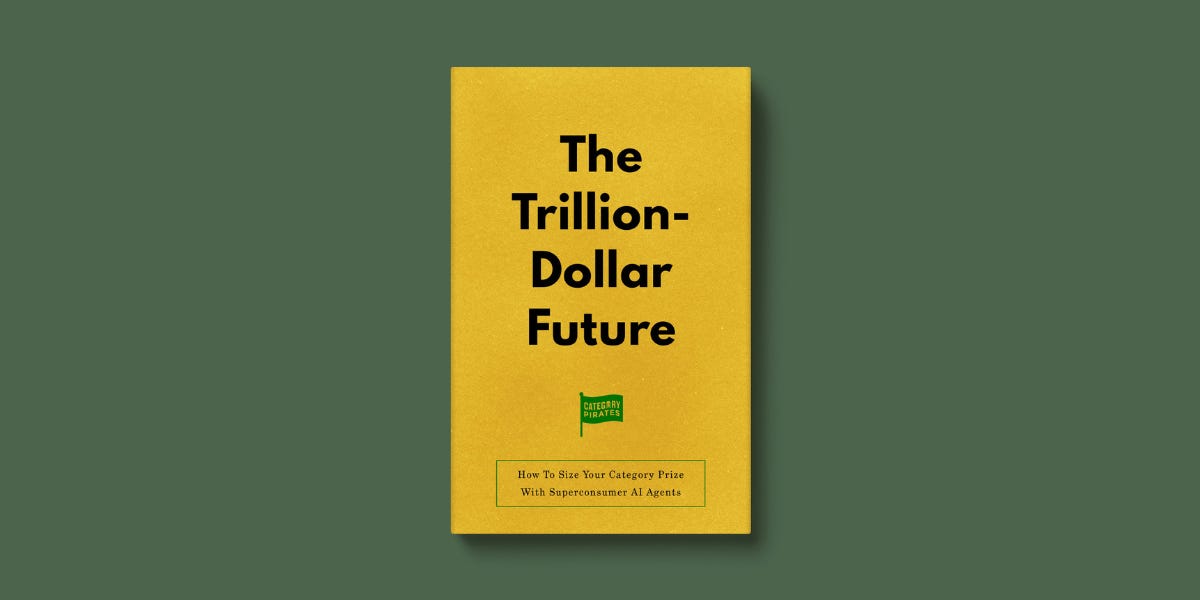Arrrrr! 🏴☠️ Welcome to a 🔒 subscriber-only edition 🔒 of Category Pirates. Each week, we share radically different ideas to help you design new and different categories. For more: Dive into an audiobook, listen to a category design jam session, or upgrade to a Founding subscription to ask the Pirate Eddie Bot your category design questions.
In the Superconsumer AI Agents mini-book, we walked through how to build a Superconsumer Agent using the data you already have.
-
You identified your Superconsumers
-
Captured their raw, unfiltered voice
-
Trained your Agent on legendary inputs
-
Fine-tuned your Agent based on results
Those first four steps are about mining existing Super data. The proof that’s hidden in your purchase history, interviews, and spending patterns.
But legendary Category Designers don’t stop with what’s already known.
They create new data that didn’t exist before. They design experiments, push boundaries, and surface insights that change the category and create a different future.
That’s why this mini-book helps you use Superconsumer Agents to size the category prize.
In business-speak, Sizing the Prize is how you find TAM (Total Addressable Market).
But don’t let the corporate jargon fool you.
Big outcomes require different behaviors. Different behaviors require exponential belief. Exponential belief requires Superconsumer size of prize analysis.
TAM is belief disguised as math. Done right, this is less about spreadsheets and more about telling a credible, compelling story about future outcomes. If you only run the numbers, you’ll miss the exponential. If you only dream, you’ll drift into fantasy.
Every leap forward in history followed this formula.
The Industrial Revolution. The dot-com boom. The AI explosion.
At first glance, these moments appear to be overnight shifts. But every one of them was powered by a handful of visionaries who stood in front of skeptics and said three things with conviction:
-
Here’s the math
-
Here’s the belief
-
Here’s why it matters now
During the Industrial Revolution, it wasn’t enough to marvel at steam engines or steel mills. You had to believe that machines could scale labor beyond human muscle. You also had to do the math on how railroads, factories, and mass production could reshape entire economies. The visionaries who fused belief with numbers built fortunes.
Those who only saw “more coal furnaces” missed the shift.
The same thing happened during the dot-com boom.
In 1994, Jeff Bezos scribbled on a napkin that internet usage was growing 2,300% a year. That was the math. The belief? Humans would one day buy everything online. Most analysts laughed.
Bezos’s napkin math, plus conviction, created Amazon, a trillion-dollar Category King.
And now we’re in the (pre) early innings of AI.
The pattern is clear.
Visionaries who could say: Here’s the math, here’s the belief, and here’s why it matters now.
Math makes the dream real.
Belief makes the math inevitable.
But size of prize analysis is hard, as Pirate Eddie wrote about in HBR, for three reasons:
-
Experts bring (too much) confirmation bias.
-
Experts’ expertise is built in the past. They’ve studied it ad nauseam.
-
Experts are rewarded with status, power, and money based on their ability to memorize and regurgitate the past.
This is why you need a Superconsumer Agent in the room. Humans get lost in bias. AI trained on Supers can help you see the exponential.
One of the most famous examples is when AT&T hired McKinsey in the 1980s to size the prize of the cell phone market in the year 2000. Their forecast was 900,000 consumers.
The actual number in 2000 was closer to 109,000,000.
They were off by three orders of magnitude.
Getting into McKinsey is harder than getting into Harvard. It’s very likely the McKinsey folks who did that analysis were super smart. However, the smarter you are, the tougher it (can) be to see different futures. Imagine new category potential.
Confirmation bias is why you can be so smart, you’re stupid.
Both matter.
Human needs, wants and problems drive every category. People are batshit emotional. We are feeling driven (even if we don’t want to admit it).
Wise marketers never forget it.
A legendary marketer we used to know named Rich Binell used to scream:
“MAKE ME CARE!”
Spreadsheet Kung Fu gurus have a hard time quantifying the emotional drive of a superconsumer on a life quest. Futurists who create and paint amazing visuals and videos about the future fall short on basic business case math and freak out when you ask them to read an S-1.
Few experts fully appreciate how challenging it can be to bring a PowerPoint slide or spreadsheet to life in real life. To create something from nothing. To size the prize, you must be part Bruce Lee with a spreadsheet, part Floyd Mayweather dodging bias, part Muhammad Ali imagining the impossible, and part Rocky Balboa refusing to quit.
Anything less, and you’re just another suit (or hoodie) with a slide deck.
This clip of Jensen Huang, Brad Gertner, and Clark Tang shows how it is done.
In three minutes, Jensen sketches a trillion-dollar TAM that investors actually believe:
-
World GDP = $110 trillion
-
Assume knowledge work is half → $50 trillion
-
Assume 20% gets augmented with AI → $10 trillion
-
Assume 50% gross margin → $5 trillion TAM
-
NVIDIA revenue today = <$0.2 trillion
-
If NVIDIA gets 100% of the market, it would grow revenue by 25x
That’s not Nostradamus.
That’s belief disguised as math.
And when credible leaders show their work this way, markets follow. Belief becomes reality.
Brad needs Jensen to lay out a simple, easy-to-follow size of prize that is compelling yet credible. Jensen needs Brad to walk with him and not roll his eyes or laugh out loud at his assumptions. Both need Clark Tang, a Partner at Altimeter, to keep both of them in check and make sure neither is high on their own supply.
But your Superconsumer AI Agent gives you a (legendary) edge.
It can run the spreadsheets like the sharpest MBA, sanity-check like a grizzled operator, and (most importantly) think like a Superconsumer on a lifelong quest. It takes the best of belief and the best of math, and fuses them into a future your investors, employees, and customers can believe in. But if you don’t anchor your TAM in belief + math, you’re just another McKinsey deck waiting to be wrong.
Before we dive into the tactical steps, remember:
-
The category size of prize is the North Star.
-
Math is the scaffolding, and belief is the engine.
-
Superconsumers are the proof.
-
Super Agents are your crew.
The goal is to build a crew of Superconsumer Agents to help you size the prize.
(If you haven’t read the Superconsumer AI Agents mini-book, read it to get the first four steps.)
Let’s dive back in.
Supers never just buy one thing.
They buy nine.
Your AI Agent’s job is to map the other eight.

